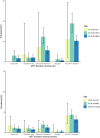Population prevalence of antiretroviral therapy sharing and its association with HIV viremia in rural Uganda: a cross-sectional population-based study
- PMID: 37705364
- PMCID: PMC10500261
- DOI: 10.1002/jia2.26135
Population prevalence of antiretroviral therapy sharing and its association with HIV viremia in rural Uganda: a cross-sectional population-based study
Abstract
Introduction: Antiretroviral treatment (ART) sharing has been reported among fishermen and sex workers in Uganda and South Africa. However, no population-based studies have documented ART diversion prevalence (including sharing [giving/receiving], buying and selling) or its relationship with viremia among men and women living with HIV in Africa.
Methods: In 2018-2020, we surveyed people living with HIV aged 15-49 years in 41 communities in the Rakai Community Cohort Study, a population-based cohort in south-central Uganda. We assessed the prevalence and correlates of self-reported lifetime and past-year ART diversion, stratifying by age and gender and documenting sources of diverted drugs. We used log-binomial regression to quantify the relationship between diversion patterns and viremia (viral load >40 copies/ml), reported as unadjusted and adjusted prevalence ratios (aPR) with 95% confidence intervals (CI).
Results: Of 2852 people living with HIV and self-reporting current ART use, 266 (9.3%) reported lifetime ART diversion. Giving/receiving drugs were most common; few participants reported buying, and none reported selling. Men (12.9%) were more likely to report lifetime diversion than women (7.4%), with men aged 25-34 reporting high levels of sharing (18.9%). Friends were the most common sources of shared drugs, followed by spouses/sexual partners. Patterns of lifetime and past-year diversion were similar. Among participants with viral load results, 8.6% were viraemic. In adjusted analyses, people who reported only giving ART were nearly twice as likely to be viraemic than those who reported no diversion (aPR: 1.94, 95% CI: 1.10-3.44), and those reporting only receiving ART were less likely to exhibit viremia (aPR: 0.46, 95% CI: 0.12-1.79), although the latter was not statistically significant. Reporting both giving and receiving ART was not associated with viremia (aPR: 0.79, 95% CI: 0.43-1.46). Reporting buying ART, though rare, was also correlated with higher rates of viremia, but this relationship was not statistically significant (aPR: 1.98, 95% CI: 0.72-5.45).
Conclusions: ART sharing is common among persons reporting ART use in rural Uganda, particularly among men. Sharing ART was associated with viremia, and receiving ART may facilitate viral suppression. HIV programmes may benefit from considering ART sharing in counselling messages.
Keywords: ART division; ART sharing; HIV adherence; HIV care continuum; Uganda; viremia.
© 2023 The Authors. Journal of the International AIDS Society published by John Wiley & Sons Ltd on behalf of International AIDS Society.
Conflict of interest statement
The authors have no competing interests to report.
Figures


Similar articles
-
Temporal dynamics and drivers of durable HIV viral load suppression and persistent high- and low-level viraemia during Universal Test and Treat scale-up in Uganda: a population-based study.J Int AIDS Soc. 2024 Feb;27(2):e26200. doi: 10.1002/jia2.26200. J Int AIDS Soc. 2024. PMID: 38332519 Free PMC article.
-
Temporal dynamics and drivers of durable HIV viral load suppression and persistent high- and low-level viremia during Universal Test and Treat scale-up in Uganda: a population-based study.medRxiv [Preprint]. 2023 Jun 16:2023.06.15.23291445. doi: 10.1101/2023.06.15.23291445. medRxiv. 2023. Update in: J Int AIDS Soc. 2024 Feb;27(2):e26200. doi: 10.1002/jia2.26200. PMID: 37398460 Free PMC article. Updated. Preprint.
-
Factors associated with unsuppressed viremia in women living with HIV on lifelong ART in the multi-country US-PEPFAR PROMOTE study: A cross-sectional analysis.PLoS One. 2019 Oct 24;14(10):e0219415. doi: 10.1371/journal.pone.0219415. eCollection 2019. PLoS One. 2019. PMID: 31647806 Free PMC article.
-
Association of Medical Male Circumcision and Antiretroviral Therapy Scale-up With Community HIV Incidence in Rakai, Uganda.JAMA. 2016 Jul 12;316(2):182-90. doi: 10.1001/jama.2016.7292. JAMA. 2016. PMID: 27404186 Free PMC article.
-
Prescription drug diversion among people living with HIV: a systematic scoping review.Public Health. 2019 Dec;177:26-43. doi: 10.1016/j.puhe.2019.07.017. Epub 2019 Sep 5. Public Health. 2019. PMID: 31494360
Cited by
-
Intra- and inter-subtype HIV diversity between 1994 and 2018 in southern Uganda: a longitudinal population-based study.Virus Evol. 2024 Aug 24;10(1):veae065. doi: 10.1093/ve/veae065. eCollection 2024. Virus Evol. 2024. PMID: 39399152 Free PMC article.
-
The potential promise and pitfalls of point-of-care viral load monitoring to expedite HIV treatment decision-making in rural Uganda: a qualitative study.BMC Health Serv Res. 2024 Oct 22;24(1):1265. doi: 10.1186/s12913-024-11747-w. BMC Health Serv Res. 2024. PMID: 39434090 Free PMC article.
-
Increasing intra- and inter-subtype HIV diversity despite declining HIV incidence in Uganda.medRxiv [Preprint]. 2024 Mar 15:2024.03.14.24303990. doi: 10.1101/2024.03.14.24303990. medRxiv. 2024. PMID: 38558994 Free PMC article. Preprint.
References
-
- World Health Organization . Key facts and latest estimates on the global HIV epidemic ‐ 2021. 2022. https://cdn.who.int/media/docs/default‐source/hq‐hiv‐hepatitis‐and‐stis‐... (accessed 28 September 2022).
Publication types
MeSH terms
Substances
Grants and funding
LinkOut - more resources
Full Text Sources
Medical
Miscellaneous

